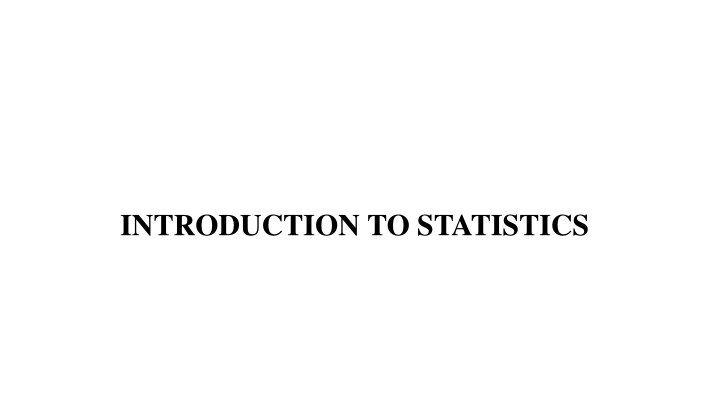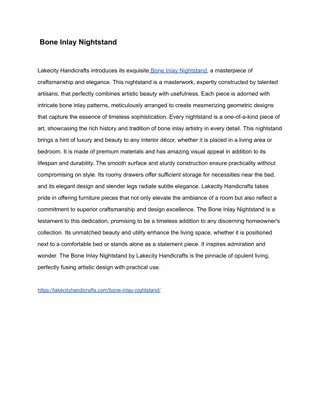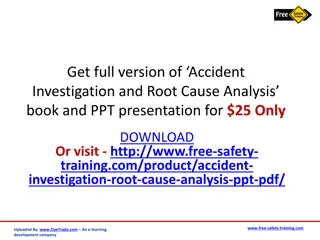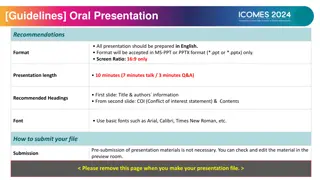
Scope of Statistics in Various Fields
Explore the comprehensive definitions and diverse scopes of statistics, ranging from social sciences to business management. Statistics play a crucial role in analyzing data, interpreting trends, and making informed decisions across various sectors.
Download Presentation

Please find below an Image/Link to download the presentation.
The content on the website is provided AS IS for your information and personal use only. It may not be sold, licensed, or shared on other websites without obtaining consent from the author. If you encounter any issues during the download, it is possible that the publisher has removed the file from their server.
You are allowed to download the files provided on this website for personal or commercial use, subject to the condition that they are used lawfully. All files are the property of their respective owners.
The content on the website is provided AS IS for your information and personal use only. It may not be sold, licensed, or shared on other websites without obtaining consent from the author.
E N D
Presentation Transcript
Definitions Statistics is a numerical statement of facts in any department of enquiry placed in relation to each other . Statistics are the classified facts representing the conditions of the people in a State specially those facts which can be stated in numbers or any tabular or classified arrangement . Statistics can be defined as the aggregate of facts affected to a marked extent by multiplicity of causes, numerically expressed, enumerated or estimated according to a reasonable standard of accuracy, collected in in a systematic manner, for a pre-determined purpose and placed in relation to each other . Statistics is the science of collecting, organizing , analyzing, interpreting and presenting data. -Bowley -Webster -Secrist
SCOPE OFSTATISTICS 1. Social Sciences -Man Power Planning -Crime Rates -Income & Wealth Analysis of Society -In studying Pricing, Production, Consumption, Investments & Profits etc. 2. Planning -Agriculture -Industry -Textiles -Education etc. For ex. Five Year Plans in India.
SCOPE OFSTATISTICS contd 3. Mathematics -Extensive use of Differentiation, Algebra, Trigonometry, Matrices etc in modern business analysis. -Statistics now treated as Applied Mathematics. 4. Economics - Family Budgeting -Applied in solving economic problems related to production, consumption, distribution of products as per income & wealth related patterns, wages, prices, profits & individual savings, investments, unemployment & poverty etc.
SCOPE OFSTATISTICS contd 5. BusinessManagement - TrendAnalysis - Market Research &Analysis - Product Life Cycle i) Marketing Marketing Policy Decisions depend on forecasting, demand analysis, time & motion studies, inventory control, investments & analysis of consumer data for production & sales.
SCOPE OFSTATISTICS contd ii) Production - Designs - Methods of Production - Technology Selection - Quality Control Mechanisms - Product Mix - Quantities - Time Schedules for Manufacturing & Distribution
SCOPE OFSTATISTICS contd iii) Finance -Correlation Analysis of profits & dividends, assets & liabilities -Analysis of income & expenditure -Financial forecasts, break-even analysis, investment & risk analysis iv) Sales -DemandAnalysis -Sales Forecasts v) Personnel - Wage plans, Incentive plans, Cost of living, Labor turnover ratio, Employment trends, Accidental Rates, Performance Appraisals etc.
SCOPE OFSTATISTICS contd vi) Accounting & Auditing -Analysis of Income, Expenditure, Investment, Profits and Optimization of Production etc - Forecasting costs of production & price vii) Other Areas -Insurance, Astronomy, Social Sciences, Medical Sciences, Psychology, Education etc.
LIMITATIONS OF STATISTICS Does not study individual items, deals with aggregates. Statistical laws are not exact. Not suitable for the study of qualitative phenomenon. Statistical methods are only means and not end for solvingproblems.
Definitions Continued Observations: Numerical quantities that measure specific characteristics. Examples include height, weight, gross sales, net profit,etc.
Some More Definitions Raw Data: Data collected in original form. Classes / class intervals: Subgroups within a set of collected data. Ex.10-20,20-30 etc Width of class-interval = upper limit lower limit Mid Value = (U.L + L.L)/2 Frequency: The number of times a certain value or class of values occurs. Frequency Distribution Table: The organization of raw data into table form using classes and frequencies.
More Definitions Cumulative Frequency of a class is the sum of the frequency of that class and the frequencies of all the preceding or succeeding classes which are listed in some sensible order (numerical order, alphabetical order, etc.)
Illustration Individual Series Marks of ten students of a class in Statistics 15, 35, 55, 67, 78, 84, 79, 90, 89,94
Illustration Discrete Frequency Distribution Height (in inches) No. of Students 60 12 62 18 64 10 66 6 68 4
Illustration Grouped or Continuous Frequency Distribution Class- Intervals Frequency Exclusive Type Class Intervals 20-25 8 25-30 2 30-35 40 35-40 23 40-45 9
Illustration Grouped or Continuous Frequency Distribution contd Inclusive Type Class - Intervals Class- Intervals Frequency 1-10 2 11-20 6 21-30 10 31-40 15 41-50 12
CONVERSION OF INCLUSIVE TYPE CLASS- INTERVALS TO EXCLUSIVE INTERVALS TYPE CLASS Calculate ADJUSTMENT FACTOR as follows: A.F= Lower Limit of Next C.I Upper Limit of 2 PreviousC.I using the given inclusive type class intervals. 2. Obtain new class intervals Lower limit A.F New Upper Limit = Old Upper Limit +A.F as follows: New Lower Limit = Old
CONVERSION OF INCLUSIVE TYPE CLASS- INTERVALS TO EXCLUSIVE TYPE CLASS INTERVALS contd Class- Intervals Frequency A.F = (11 10)/2 = 0.5 For 1st C.I i.e1-10 New L.L = 1(old L.L) 0.5 = 0.5 New U.L=10(old U.L) +0.5 = 10.5 And so on. 1-10 2 11-20 6 21-30 10 31-40 15 41-50 12
CONVERSION OF INCLUSIVE TYPE CLASS- INTERVALS TO EXCLUSIVE TYPE CLASS INTERVALS contd Class- Intervals Frequency 0.5-10.5 2 Now calculations can be made. 10.5-20.5 6 20.5-30.5 10 30.5-40.5 15 40.5-50.5 12
Obtaining Cumulative Frequency Distribution Class -Intervals Frequency Less than type cum frequency More than type cum frequency 15 60+15=75 20-25 15 25-30 34 15 +34 =49 26 + 34 = 60 30-35 6 49 + 6 =55 20 + 6 = 26 35-40 10 55 + 10 = 65 10 + 10 = 20 40-45 8 65 + 8 = 73 2 + 8 = 10 45-50 2 73 + 2 = 75 2






















